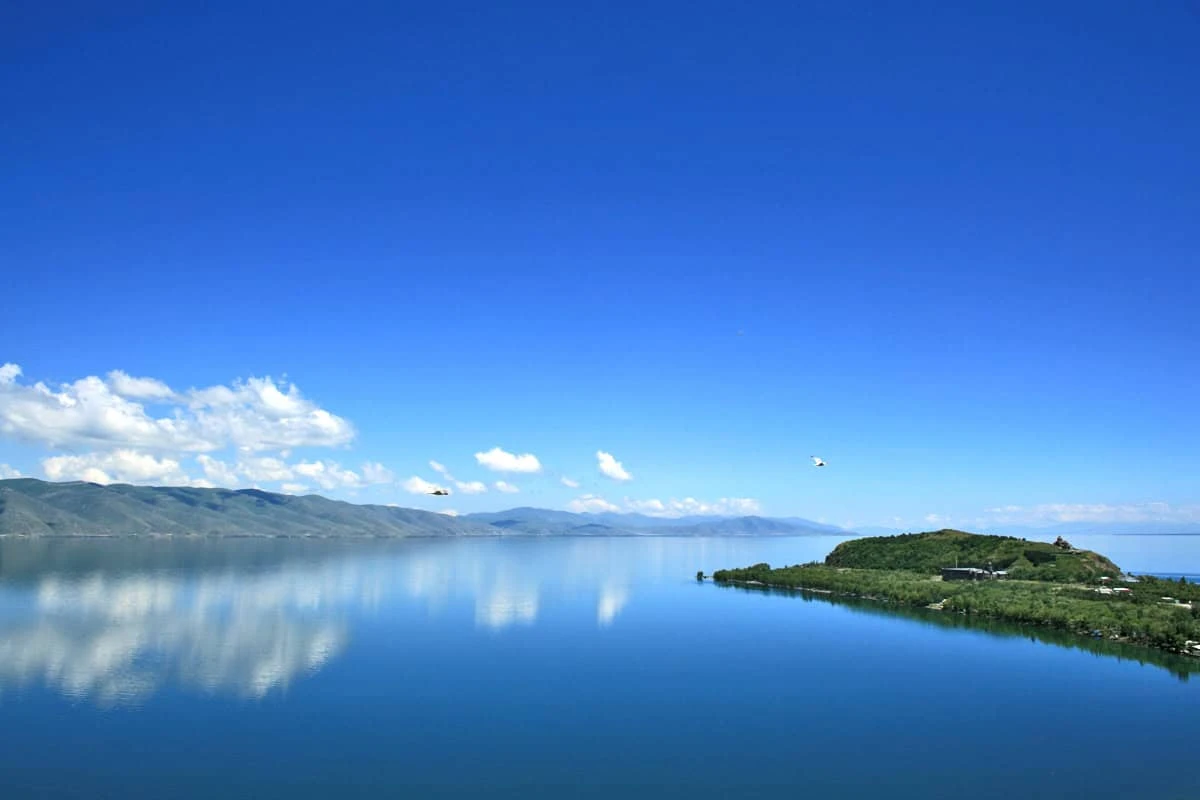Armenia is called the land of churches. Indeed, many early Christian churches and monasteries have been preserved here, which fascinate with the thickness of their walls and the amazing history. And apart from them, the country has something to show at any time of the year. Majestic mountains and prehistoric buildings are adjacent to modern cities and 5-star hotels, so you do not have to choose between natural beauty and comfort. We have prepared a list of the most interesting attractions of Armenia for you and described below how to get to them from the capital.
Both private and group tours can be organized.
Natural attractions
Lake SevanLake Sevan is called the Armenian Sea – it is the main freshwater reservoir in the country, which occupies 1240 km2, about 5% of the area of Armenia. Sevan is located in the mountains at an altitude of 1900 m above sea level. After a series of unsuccessful actions by the Soviet authorities, the lake began to gradually dry up: at such a scale that the island where the Sevanavank monastery is located turned into a peninsula. That is why by the beginning of the 1980s, a tunnel was dug connecting the Arpa River and Sevan for additional fresh water supply. As a result, by the beginning of the 2000s, the water level began to slowly recover.
In summer, Sevan turns into a beach holiday area. Despite the fact that the water in it does not warm up above 20 degrees, locals and tourists swim in it, and also go diving and windsurfing. There are restaurants and cafes on the shore.Sevan is located about 60 km from Yerevan. On the way, we recommend visiting Master Levon's Divine Underground: this is an amazing underground labyrinth, carved out of a basalt block to a depth of 21 m by one man armed with a hammer and chisel.

Lake Sevan
Mount AraratIt is one of the symbols of Armenia. The mountain is depicted on the country's coat of arms, it is the name of a football club and a good cognac.
But since the year of 1921, after the signing of the Treaty of Kars, there have been changes in the borders of the countries and Ararat has passed to Turkey. Although this does not prevent Armenians from considering it their own. Ararat is closely connected with the Bible: it is believed that it was here that Noah's Ark stopped after the Great Flood and from here the new history of mankind began. But if Armenians cannot get to Ararat without crossing the border with Turkey, then no one forbids them to look at it.In good weather, Ararat is perfectly visible from Yerevan. Initially, the city was built in such a way as to be like an amphitheater in front of the majestic sacred mountain. Unfortunately, modern buildings no longer take this detail into account, so for beautiful views you need to climb the Cascade, an architectural complex of five terraces. From the upper level, there opens a panorama of the city with Ararat on the horizon. You can look at the mountain from a different angle when visiting Khor Virap Monastery.

Mount Ararat
"Khosrov Forest" State ReserveThis is a unique place, if for no other reason than because it was declared a protected area by the King of Armenia Khosrov III back in the 4th century. For 17 centuries, the Armenians have managed to preserve this forest almost untouched, in its natural biodiversity. Now its area is 23.000 hectares, where rare representatives of the Armenian flora and fauna live. For example, only here one can meet a black vulture. In addition to it, among the protected animals and birds here live the griffon vulture, the Egyptian vulture, the bezoar goat and the Western Asian leopard.
The landscape of the reserve is heterogeneous: here you can admire mountain landscapes, waterfalls hidden in the forest, as well as an amazing natural structure – the "Basalt Organ" (another name is the "Symphony of Stones"). These are basalt columns in the gorge of the Azat River, formed by cooling magma. And above them rises the Garni Temple.
There are campsites on the territory of the Khosrov Reserve where you can have an overnight in a tent to get to know the nature of Armenia better. The reserve itself is located approximately 70 km from Yerevan.
Dilijan National Park and Dilijan townDilijan is a city with absolutely postcard views. It is called a corner of Switzerland in Armenia. In summer it is not as hot here as in other parts of the country, the temperature rarely rises above 25 degrees. In autumn, the leaves of the trees delight with beautiful flashes of red, yellow and orange. In winter, Dilijan turns into a New Year's fairy tale, and the mild climate – frosts on average are about -5 degrees – allows one to walk for a long time. In spring, rain is possible, but flowers and green areas, as well as hot coffee in local restaurants or a glass of good wine will help you come to terms with weather.
The Dilijan National Park stretches around Dilijan. More precisely, the city is its logistics center. The park is huge, occupies an area of 240 km2, rare species of animals and plants are preserved here. Also, here the ancient monasteries of Haghartsin, Goshavank and Matosavank are located, as well as the beautiful Lake Parz, lost in the middle of the forest. From Yerevan to Dilijan Park it's about 100 km.
Historical attractions
Garni TempleGarni is one of the surviving pagan temples in Armenia. The construction date is approximately the 1st century AD. It is dedicated to Mihr, the God of Sun in ancient Armenian mythology. Garni is the only Greco-Roman style structure in the country that has survived to this day, it is the symbol of pre-Christian Armenia. It is still unknown why the temple was not destroyed after the adoption of Christianity like other pagan structures. Historians have a version that it served as a burial vault, and for that very reason it remained untouched. At the beginning of the 4th century, it began to be used as a summer royal residence.
During the earthquake of 1679, the temple was destroyed and rebuilt in the second half of the 20th century according to the design of the architect A. Shahinyan. The reconstruction was carried out using the anastylosis method, meaning that restorers try to preserve the original look of the structure as much as possible, using the original building elements. Unfortunately, it is empty inside, the statue of the God of the Sun has not survived. You can admire the intricate ornamentation and stunning views of the mountain gorge where the temple is located. Next to it, you can observe the royal baths – even the mosaic floor has been preserved, and if you are traveling to Garni from Yerevan – make a stop in the village of Voghjaberd to visit the Arch of Charents, built in 1957 by Rafayel Israyelian.

Garni Temple

Garni Gorge
Zorats KarerIt is called the Armenian Stonehenge, but according to Armenian historians, the megalithic complex Zorats Karer may be 3 thousand years older than its British "colleague". According to various estimates, it was built between 5.7 and 2000 years BC. The name translates as "stone army", Armenians say that according to legend, warriors with a commander are buried under the stones. Another name, Karahunj, can be translated from Armenian as "singing stones": the wind, that passes through the holes in the ancient boulders, makes a sound.
There are also several versions about the origin of these holes, located in the upper part of some stones. The most interesting of them was first put forward by archaeologist O. Khnkikyan: he suggested that Zorats Karer was an ancient observatory. Some of the stones can indeed be associated with the phases of the Moon, as well as the sunrises and sunsets, but not all of them, so it still remains a hypothesis. Although those who managed to visit Karahunj at night say that there are excellent conditions for observing the stars. The view is not obstructed by city lights, and the nearest town, Sisian, is about 5 km away. Zorats Karer is marked on maps as an attraction, and a dirt road leads to the complex itself.

Zorats Karer
ZvartnotsZvartnots is an amazing temple, an architectural monument of the 7th century. It was built in honor of Gregory The Illuminator, the name is translated from ancient Armenian as "the temple of the vigilant angels".
The site is included in UNESCO Cultural World Heritage List.
In the 10th century, Zvartnots was destroyed by an earthquake. And only at the beginning of the 20th century, archaeologists found it. Unfortunately, the excavations were not carried out by specialists, which affected the preservation of the ruins. Architect Toros Toramanyan made a great contribution to the study of the temple. He himself participated in the excavations, and later presented his project for the reconstruction of the temple. According to Toramanyan, Zvartnots had a round base and 3 tiers. The lower one was surrounded by a two-story ring-shape gallery, the second one – a rotunda wall, the third one was a dome with a 16-sided drum. One can see the architectural model in the museum of the temple. The surviving elements of the temple: capitals with eagles and curls, friezes decorated with grapevines, etc., speak of the influence of Syrian and Mesopotamian architecture.Experts call the current state of the Zvartnots temple an exposition of archaeological excavations. Proposals for restoration have been repeatedly put forward, however were rejected due to the fact that the ancient foundation could totally collapse. But even now the ruins look impressive and majestic, especially in good weather, when Ararat is clearly visible in the background. The complex is located not far from Yerevan, about 20 km away.

Zvartnots temple
Amberd FortressThere are many ancient structures preserved in Armenia, but there are very few fortifications that do not belong to monasteries. Amberd is translated from Armenian as "fortress in the clouds". It is located on the slope of Mount Aragats at an altitude of 2300 m above sea level. In 2024, "Europe Nostra" included Amberd in the list of European monuments on the verge of destruction. Erosion, earthquakes and lack of funds for restoration can destroy the fortress, thus, in case there is a possibility, we recommend visiting it in the near future.
Amberd started to be built by the Kamsarakan princes around the 7th century, judging by other buildings of the same time. There are no mentions of the fortress in written sources of this historical period. In the 10th century, it was rebuilt and fortified, in the 11th century, the Vahramashen Church (Surb Astvatsatsin Katoghike) was built next to it. In 1236, the fortress was almost destroyed by the Mongols, then it was restored by the Vachutyan princes, but there is no further information about it. Most likely, the Amberd fortress was destroyed by the troops of Tamerlane.
The fortress was discovered during archaeological excavations in the 20th century. It itself is poorly preserved, but the stone baths located nearby have been almost completely restored. The Vahramashen church has also been reconstructed. The complex is located about 50 km from Yerevan. Please note, that on the way to the church on the slope of Mount Aragats there is an anomalous zone (marked on Yandex.Maps). Here, the laws of gravity are violated, the car itself moves up the mountain and not down, even the mountain river flows up. There is a version that the latter is an electromagnetic anomaly or a local curvature of gravity.

Amberd Fortress
Religious attractions
Armenia is the first country to officially adopt Christianity as a state religion (in the year of 301). Therefore, there are many temples and monasteries here. Religious structures are placed in beautiful locations, and often look more like ancient castles than monastic communities. Any of them can be recommended for visiting, but we will list those that seemed the most interesting to us.Vagharshapat (Echmiadzin)
It is called the Armenian Vatican: it was here in 301 that the baptism of the Armenian nation took place, also the residence of the Catholicos of All Armenians is located here. It is one of the oldest cities in the country, according to historians, it was founded in the 2nd century BC. After the baptism, cathedrals and churches began to be built on the site of pagan temples. The first to be built was the Echmiadzin Mother Cathedral (301), it is located in Vagharshapat and, thanks to restoration, has survived to this day.
The site is included in UNESCO World Cultural Heritage List.
Also in Vagharshapat there is "Treasures of Echmiadzin" museum. Real relics are kept here: the spear of Longinus, which a warrior thrust into Jesus Christ crucified on the cross, a piece of Noah's Ark, relics of saints, including the right hand of Gregory The Illuminator. In addition, in Echmiadzin there are located St. Hripsime church (year of 618), St. Gayane church (year of 630) and other religious buildings. It is about 20 km from Yerevan to Vagharshapat.

Echmiadzin Museum: a touch of the sacred
Khor VirapThis monastery is interesting not only for its beautiful view of Ararat, but also for its history. It was founded in 642 on the site of an underground prison where Saint Gregory The Illuminator, the first Armenian Catholicos, had been kept for 13 years. The underground dungeon has survived to this day, and anyone can go down the almost vertical stairs and see the conditions in which the prisoner was kept. This is a real stone "sack", 6 m deep and 4 m wide. Many people who appear here, say that it is difficult to breathe inside, panic sets in – and in ancient times, judging by the chronicles, poisonous snakes and scorpions kept prisoners company. One had to have incredible strength of spirit not to go crazy here and maintain faith.
The monastery itself is surrounded by thick protective walls. Inside there is a functioning Church of the Holy Mother of God, a chapel, and a church shop. Distance from Yerevan: about 40 km.

Khor Virap Monastery
TatevTatev Monastery is located in the Syunik region and is part of the "Tatev Gateway" tourist complex. It is a non-profit project, all profits go to the restoration of the monastery. It is possible to get to the monastery by car, but there is a much more interesting way: by the "Wings of Tatev" cable car. It is the longest reversible cableway in the World, recorded in the Guinness Book of Records. The length of the flight is almost 6 km. The road passes at an altitude of 350 m above the gorge, from where other sights of Armenia are clearly visible: the ruins of the Great Hermitage of Tatev, the Harsnadzor watchtower, etc.
The year of foundation of the monastery is 906. During this period, the monastery repeatedly suffered from the troops of Tamerlane, then from the cavalry of Shahrukh. But all the time it remained a major center of science and education in Armenia. And in 1921, the Republic of Mountainous Armenia was proclaimed here.
Tatev is located 250 km from Yerevan, not far from the city of Goris. We recommend setting aside 2 days for the trip: spend one day in Tatev, stay overnight in Goris and the next day visit the cave city of Khndzoresk there. People used to live in these caves at the beginning of the 20th century.

Tatev Monastery

Wings of Tatev Ropeway
Tours to all the listed attractions can be purchased online on the pages "Group Tours" and "Private Tours", you can also contact us through the form on the website or else by phone, we will create a route for you, mention what else to see along the way, provide transportation and accommodation, and also give you a list of the best cafes and restaurants with real Armenian cuisine. We will make sure that you feel at home during your trip to Armenia and help you fall in love with this country from the first acquaintance.












